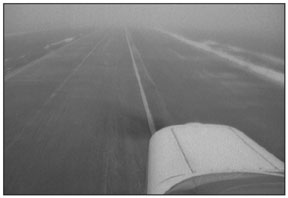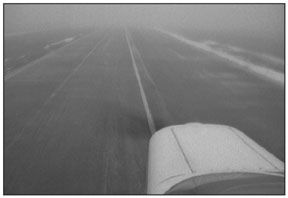
After a great day at the Block Island State Airport (BID) my wife and I departed IFR back to the Brookhaven Airport (HWV), a non-towered airport on Long Island. A marine layer began to move in, not uncommon in this area in August. After a brief climb through 200-foot ceilings, we broke out into bright sunshine and were soon cruising at 6000 feet.
I was concerned that the same marine layer was moving in on the entire south shore of Long Island. I tuned in the weather at HWV and within 15 minutes of departing BID the ceilings went from 1500 scattered to 1100 broken. Over the Hamptons, the controller asked which approach I would like into HWV. With the latest weather reporting ceilings at 900 broken, I requested the ILS Runway 6 procedure.
One last weather check while being vectored onto the final approach course revealed that ceilings were variable between 400 and 900 feet. The minimums at HWV are 309 feet, with a circle-to-land minimum of 600 feet. The approach was working out well, and I was reassuring my nervous wife that everything was just as it should be. And it was. Cleared for the approach I captured the localizer, then the glideslope. Two miles from the outer marker, approach instructed me to change to the local frequency and cancel on the ground.
I self-announced my position on the CTAF at one-mile intervals as I worked to hold both needles. At 700 feet, with no ground in sight, and with the wind from 220 at four knots, I decided to land on Runway 6 as I would probably break out near, or under, circling minimums. At 600 feet, I made what I thought would be my last position announcement from about two nm out.
To my surprise, a voice reported, Traffic on the ILS 6, theres a Cessna on final, Runway 24, two miles out, visual. Hoping he was somewhere else, I keyed the mic and asked, Traffic on final for 24, are you going into Brookhaven? He answered, Yes, Brookhaven 24. Now at 500 feet and not yet clear of clouds, I was setting up to land on a runway with another airplane about the same distance out from the opposite direction.
After assessing my options, which included the turf beside the runway and the parallel taxiway, I knew what I would do but I didnt know what he would do.
In the end, my decision was to add full throttle and side-step away from the runway, climbing as quickly as I could. As I crossed over Rwy 6 at 800 feet, the Cessna announced he was down on 24. I made the right decision, as we would have both touched down at the same time, the same runway, opposite direction.
I diverted to my alternate, the Long Island Mac Arthur Airport in Islip, New York, where the ceilings were reported at 800 broken. Within a few minutes, we were cleared for the approach and made an uneventful landing.
The lesson of maintaining situational awareness, always having options, and being prepared was reinforced by this experience. This was a very good example of how a perfectly routine approach to a very familiar airport can suddenly turn ugly.




